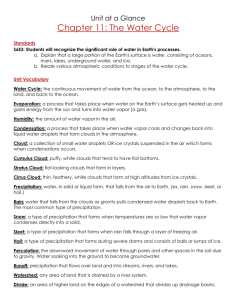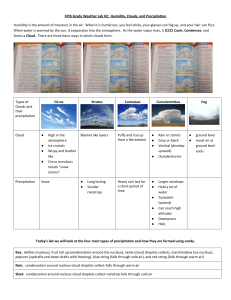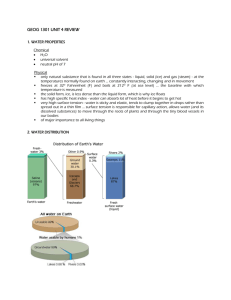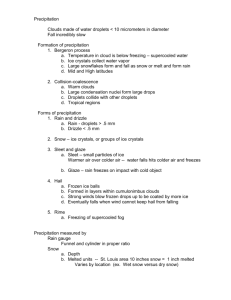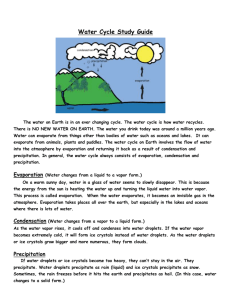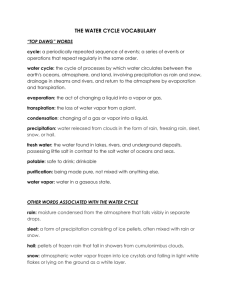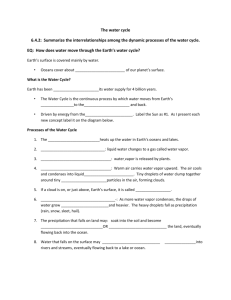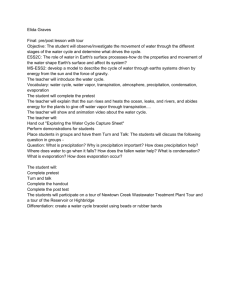The water cycle has no starting point
advertisement
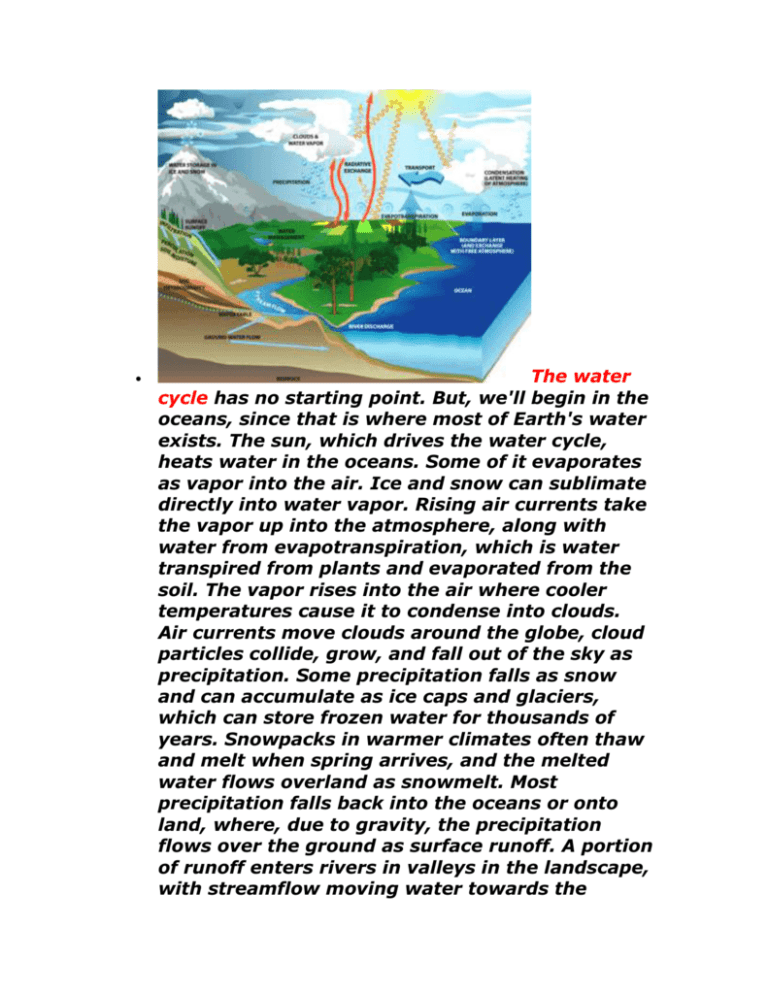
The water cycle has no starting point. But, we'll begin in the oceans, since that is where most of Earth's water exists. The sun, which drives the water cycle, heats water in the oceans. Some of it evaporates as vapor into the air. Ice and snow can sublimate directly into water vapor. Rising air currents take the vapor up into the atmosphere, along with water from evapotranspiration, which is water transpired from plants and evaporated from the soil. The vapor rises into the air where cooler temperatures cause it to condense into clouds. Air currents move clouds around the globe, cloud particles collide, grow, and fall out of the sky as precipitation. Some precipitation falls as snow and can accumulate as ice caps and glaciers, which can store frozen water for thousands of years. Snowpacks in warmer climates often thaw and melt when spring arrives, and the melted water flows overland as snowmelt. Most precipitation falls back into the oceans or onto land, where, due to gravity, the precipitation flows over the ground as surface runoff. A portion of runoff enters rivers in valleys in the landscape, with streamflow moving water towards the oceans. Runoff, and ground-water seepage, accumulate and are stored as freshwater in lakes. Not all runoff flows into rivers, though. Much of it soaks into the ground as infiltration. Some water infiltrates deep into the ground and replenishes aquifers (saturated subsurface rock), which store huge amounts of freshwater for long periods of time. Some infiltration stays close to the land surface and can seep back into surface-water bodies (and the ocean) as ground-water discharge, and some ground water finds openings in the land surface and emerges as freshwater springs. Over time, though, all of this water keeps moving, some to reenter the ocean, where the water cycle "ends" ... oops - I mean, where it perception The clouds floating overhead contain water vapor and cloud droplets, which are small drops of condensed water. These droplets are way too small to fall as precipitation, but they are large enough to form visible clouds. Water is continually evaporating and condensing in the sky. If you look closely at a cloud you can see some parts disappearing (evaporating) while other parts are growing (condensation). Most of the condensed water in clouds does not fall as precipitation because their fall speed is not large enough to overcome updrafts which support the clouds. For precipitation to happen, first tiny water droplets must condense on even tinier dust, salt, or smoke particles, which act as a nucleus. Water droplets may grow as a result of additional condensation of water vapor when the particles collide. If enough collisions occur to produce a droplet with a fall velocity which exceeds the cloud updraft speed, then it will fall out of the cloud as precipitation. This is not a trivial task since millions of cloud droplets are required to produce a single raindrop. A more efficient mechanism (known as the BergeronFindeisen process) for producing a precipitationsized drop is through a process which leads to the rapid growth of ice crystals at the expense of the water vapor present in a cloud. These crystals may fall as snow, or melt and fall as rain. Relative Humidity As the relative humidity of the air surrounding the plant rises the transpiration rate falls. It is easier for water to evaporate into dryer air than into more saturated air. Wind and air movement: Increased movement of the air around a plant will result in a higher transpiration rate. This is somewhat related to the relative humidity of the air, in that as water transpires from a leaf, the water saturates the air surrounding the leaf. If there is no wind, the air around the leaf may not move very much, raising the humidity of the air around the leaf. Wind will move the air around, with the result that the more saturated air close to the leaf is replaced by drier air. Soil-moisture availability: When moisture is lacking, plants can begin to senesce (premature ageing, which can result in leaf loss) and transpire less water. Type of plant: Plants transpire water at different rates. Some plants which grow in arid regions, such as cacti and succulents, conserve precious water by transpiring less water than other plants. Although some definitions of evapotranspiration include evaporation from surface-water bodies, such as lakes and even the ocean, on this Web site, evapotranspiration is defined as the water lost to the atmosphere from the ground surface and the transpiration of groundwater by plants through their leaves. Transpiration: The release of water from plant leaves Transpiration is the process by which moisture is carried through plants from roots to small pores on the underside of leaves, where it changes to vapor and is released to the atmosphere. Transpiration is essentially evaporation of water from plant leaves. It is estimated that about 10 percent of the moisture found in the atmosphere is released by plants through transpiration. Plant transpiration is an invisible process—since the water is evaporating from the leaf surfaces, you don't just go out and see the leaves "breathing". During a growing season, a leaf will transpire many times more water than its own weight. A large oak tree can transpire 40,000 gallons (151,000 liters) per year. Although the water cycle sounds like it is describing the movement of water, in fact, much more water is in storage at any one time than is actually moving through the cycle. By storage, we mean water that is locked up in its present state for a relatively long period of time, such as in ice caps and glaciers. The vast majority, almost 90 percent, of Earth's ice mass is in Antarctica, while the Greenland ice cap contains 10 percent of the total global ice-mass. The Greenland ice cap is an interesting part of the water cycle. The ice cap became so large over time (about 600,000 cubic miles (mi3) or 2.5 million cubic kilometers (km3)) because more snow fell than melted. Over the millenia, as the snow got deeper, it compressed and became ice. The ice cap averages about 5,000 feet (1,500 meters) in thickness, but can be as thick as 14,000 feet (4,300 meters). The ice is so heavy that the land below it has been pressed down into the shape of a bowl. In many places, glaciers on Greenland reach to the sea, and one estimate is that as much as 125 mi3 (517 km3) of ice "calves" into the ocean each year—one of Greenland's contributions to the global water cycle. Ocean-bound icebergs travel with the currents, melting along the way. Some icebergs have been seen, in much smaller form, as far south as the island of Bermuda. The water vapor rises in the atmosphere and cools. The cooler temperature turns the water vapor into tiny water droplets by a process called condensation. Those water droplets make up clouds. The water droplets grow larger when they combine with each other. In time, they become too heavy to stay in the air. Then they fall to the ground as rain, snow and other types of precipitation. Most of the precipitation that falls becomes a part of the ocean or part of rivers, lakes, and streams that lead to the ocean. Some of the snow and ice that falls as precipitation stays at the Earth surface in glaciers and other types of ice. Some of the precipitation seeps into the ground and becomes a part of the groundwater. http://ga.water.usgs.gov/edu/watercyclesummary.html
